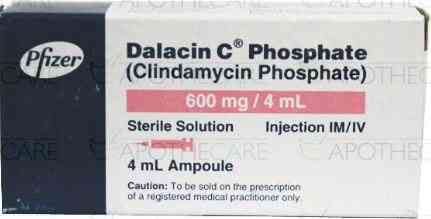Clindamycin
Welcome to Dwaey, specifically on Clindamycin page.
This medicine contains important and useful components, as it consists of
Clindamycin is available in the market in concentration.
Generic Name of Clindamycin - Learn More
Clindamycin
Clindamycin Precaution - What You Need to Know
Before starting Clindamycin, patients must consult with their healthcare provider, as there are important precautions to consider:
- History of Gastrointestinal Disorders: Clindamycin has been associated with Clostridium difficile-associated diarrhea (CDAD), a severe form of colitis. It should be used cautiously in patients with a history of gastrointestinal diseases like colitis or Crohn’s disease.
- Liver and Kidney Dysfunction: Clindamycin is metabolized by the liver and excreted by the kidneys. Patients with liver or renal impairment may require dose adjustments or close monitoring due to potential toxicity.
- Hypersensitivity Reactions: People who have experienced allergic reactions to clindamycin or lincomycin, another lincosamide antibiotic, should avoid using this drug. Severe reactions like anaphylaxis, rash, or difficulty breathing require immediate medical attention.
- Pregnancy and Breastfeeding: Clindamycin is categorized as a Category B drug during pregnancy, which suggests it may be used when clearly needed. Caution is recommended during breastfeeding, as the drug can be excreted in breast milk, although serious effects on the infant are rare.
- Antibiotic Resistance: Prolonged or inappropriate use of clindamycin increases the risk of developing antibiotic-resistant bacteria. It should only be used for the prescribed indications and duration.
Clindamycin Indication - Uses and Benefits
Clindamycin is an antibiotic in the lincosamide class, used to treat a variety of bacterial infections, including:
- Skin and Soft Tissue Infections: Clindamycin is commonly prescribed for skin and soft tissue infections like cellulitis, abscesses, and impetigo, often caused by *Staphylococcus aureus* or *Streptococcus pyogenes*.
- Bone and Joint Infections: It is effective in treating osteomyelitis and septic arthritis caused by susceptible bacteria.
- Respiratory Infections: Clindamycin is used for certain types of respiratory infections, including pneumonia caused by susceptible organisms like *Streptococcus pneumoniae* and *Staphylococcus aureus*.
- Gynecological Infections: It is prescribed for pelvic inflammatory disease (PID) and other gynecological infections caused by anaerobic organisms.
- Severe Infections and Sepsis: In combination with other antibiotics, clindamycin may be used to treat sepsis or severe infections where multiple bacteria are involved.
- Toxins Associated with *Clostridium perfringens*: Clindamycin is used in combination with other agents to treat infections caused by *Clostridium perfringens* and to inhibit the production of toxins.
Clindamycin Contraindications - Important Warnings
Clindamycin should not be used in certain conditions due to safety concerns:
- Allergy to Clindamycin or Lincomycin: Patients with a known hypersensitivity to clindamycin, lincomycin, or other components of the drug should avoid its use.
- History of Colitis: It is contraindicated in patients with a history of colitis, especially antibiotic-associated colitis, or a history of severe gastrointestinal reactions like C. difficile-associated diarrhea (CDAD).
- Severe Liver or Kidney Dysfunction: In patients with severe hepatic or renal impairment, the use of clindamycin may be contraindicated due to the potential for drug accumulation and toxicity.
- Concurrent Use with Certain Antimicrobials: In certain cases, clindamycin should not be used in combination with other antibiotics that may lead to adverse interactions, such as aminoglycosides.
Clindamycin Side Effects - What to Expect
Clindamycin can cause both mild and severe side effects, which patients should monitor:
- Gastrointestinal Disturbances: The most common side effects are nausea, vomiting, abdominal pain, and diarrhea. Diarrhea, especially watery or bloody stools, can be a sign of a serious condition like C. difficile-associated colitis and requires immediate medical attention.
- Skin Rash: Allergic skin reactions, such as rashes or itching, are common. Severe reactions such as Stevens-Johnson syndrome or toxic epidermal necrolysis, though rare, can occur and require emergency intervention.
- Liver Toxicity: Elevated liver enzymes can indicate hepatotoxicity. Symptoms like jaundice, dark urine, or severe abdominal pain should be promptly reported.
- Clostridium Difficile Infection: Clindamycin is known to cause antibiotic-associated colitis, including C. difficile-related infections, which can be life-threatening. Diarrhea with mucus or blood is a critical sign that requires immediate medical attention.
- Blood Dyscrasias: Rare but serious side effects include blood disorders like leukopenia, eosinophilia, or thrombocytopenia. Symptoms like unexplained fever or easy bruising should be reported.
- Allergic Reactions: Serious allergic reactions like anaphylaxis, including difficulty breathing, swelling, or tightness in the chest, require emergency medical treatment.
Clindamycin Pregnancy Category ID - Safety Information
2
Clindamycin Mode of Action - How It Works
Clindamycin is an antibiotic that works by inhibiting bacterial protein synthesis. It binds to the 50S ribosomal subunit of the bacterial cell, preventing the elongation of the protein chain during translation. This inhibits bacterial growth and replication, ultimately leading to bacterial cell death.
- Bacteriostatic Effect: Clindamycin acts as a bacteriostatic agent, meaning it inhibits bacterial growth rather than directly killing the bacteria. This allows the immune system to clear the infection.
- Broad Spectrum of Activity: It is particularly effective against Gram-positive bacteria, including *Staphylococcus aureus* and *Streptococcus pyogenes*, as well as some anaerobic bacteria like *Bacteroides* and *Clostridium* species.
- Targeting Protein Synthesis: By preventing the formation of essential bacterial proteins, clindamycin disrupts bacterial metabolism and growth, rendering bacteria unable to survive or replicate.
Clindamycin Drug Interactions - What to Avoid
Clindamycin interacts with several drugs, which can affect its efficacy and safety:
- Neuromuscular Blockers: Clindamycin can potentiate the effects of neuromuscular blocking agents, which may increase the risk of respiratory depression or paralysis during surgery.
- Antagonistic Effects with Some Antibiotics: The combination of clindamycin with certain antibiotics, such as aminoglycosides (e.g., gentamicin), may result in antagonistic effects, meaning that they can reduce each other’s bactericidal activity when used together.
- CYP450 Enzyme Interactions: Clindamycin does not have significant interactions with cytochrome P450 enzymes, but it may interact with other antibiotics or medications that do, potentially altering their metabolism and effectiveness.
- Other Antibiotics: Combining clindamycin with other broad-spectrum antibiotics, especially those that target similar bacterial species, may lead to increased risk of resistance or inadequate bacterial coverage.
- Antacids or Calcium Supplements: Though rare, antacids containing magnesium or calcium may reduce the absorption of clindamycin when taken simultaneously. It’s advised to separate their administration by at least 2 hours.
Clindamycin Adult Dose - Recommended Dosage
The typical adult dosage of clindamycin varies depending on the type and severity of the infection:
- Mild to Moderate Infections: 150-300 mg every 6-8 hours.
- Severe Infections: 300-450 mg every 6 hours.
- Osteomyelitis: 600-1200 mg every 6-8 hours.
- Pelvic Inflammatory Disease: 450-900 mg every 8 hours for 14 days.
- Streptococcal Pharyngitis: 150-300 mg every 6 hours for 10 days.
- Sepsis: In cases of severe infection, such as sepsis, clindamycin can be administered intravenously, starting with a dose of 600-1200 mg every 8 hours.
Clindamycin is typically administered orally for non-severe infections, and intravenously for more severe cases.
Clindamycin Child Dose - Dosage for Children
The dosage of clindamycin for children is based on the child’s weight and the type of infection:
- General Dose: The usual pediatric dose is 8-25 mg/kg/day, divided into 3-4 doses daily.
- Severe Infections: For more severe infections, the dose may be increased to 30 mg/kg/day, divided into 3-4 doses.
- Osteomyelitis and Other Bone Infections: The dose can be 25-40 mg/kg/day, divided into 3-4 doses.
Children with kidney or liver impairment may require dose adjustments, and careful monitoring is essential for ensuring proper therapeutic levels and avoiding toxicity.
Always consult a healthcare provider before administering clindamycin to ensure the correct dosage and appropriate therapy.
Clindamycin Renal Dose - Dosage for Kidney Conditions
Patients with renal impairment typically require dose adjustments, as the drug is primarily excreted by the kidneys:
- Mild to Moderate Renal Impairment: No dose adjustment is typically needed in patients with mild or moderate renal impairment (creatinine clearance >30 mL/min).
- Severe Renal Impairment: In patients with severe renal impairment (creatinine clearance <30 mL/min), the dose of clindamycin should be reduced, or alternative antibiotics should be considered to avoid drug accumulation.
Patients with renal disease should be monitored carefully for potential side effects and toxicity.


